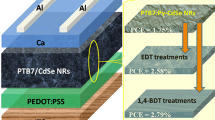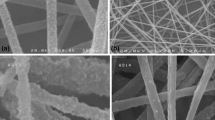Abstract
The integration of semiconductor nanoparticles (NPs) into a polymeric matrix has the potential to enhance the performance of polymer-based solar cells taking advantage of the physical properties of NPs and polymers. We synthesize a new class of CdS-NPs-based active layer employing a low-cost and low temperature route compatible with large-scale device manufacturing. Our approach is based on the controlled in situ thermal decomposition of a cadmium thiolate precursor in poly(3-hexylthiophene) (P3HT). The casted P3HT:precursor solid foils were heated up from 200 to 300 °C to allow the precursor decomposition and the CdS-NP formation within the polymer matrix. The CdS-NP growth was controlled by varying the annealing temperature. The polymer:precursor weight ratio was also varied to investigate the effects of increasing the NP volume fraction on the solar cell performances. The optical properties were studied by using UV–Vis absorption and photoluminescence (PL) spectroscopy at room temperature. To investigate the photocurrent response of P3HT:CdS nanocomposites, ITO/P3HT:CdS/Al solar cell devices were realized. We measured the external quantum efficiency (EQE) as a function of the wavelength. The photovoltaic response of the devices containing CdS-NPs showed a variation compared with the devices with P3HT only. By changing the annealing temperature the EQE is enhanced in the 400–600 nm spectral region. By increasing the NPs volume fraction remarkable changes in the EQE spectra were observed. The data are discussed also in relation to morphological features of the interfaces studied by Focused Ion Beam technique.




Similar content being viewed by others
References
Alet P-J, Palacin S, Roca I, Cabarrocas P, Kalache B, Firon M, de Bettignies R (2007) Hybrid solar cells based on thin-film silicon and P3HT. Eur Phys J Appl Phys 36:231–234
Antolini F, Pentimalli M, Di Luccio T, Terzi R, Schioppa M, Re M, Mirenghi L, Tapfer L (2005) Structural characterization of CdS nanoparticles grown in polystyrene matrix by thermolytic synthesis. Mater Lett 59:3181–3187
Borriello C, Masala S, Bizzarro V, Nenna G, Re M, Pesce E, Minarini C, Di Luccio T (2011) Electroluminescence properties of poly(3-hexylthiophene)–cadmium sulfide nanoparticles grown in situ. J Appl Polym Sci. doi:10.1002/app.34774
Bouclé J, Ravirajan P, Nelson J (2007) Hybrid polymer–metal oxide thin films for photovoltaic applications. J Mater Chem 17:3141–3153
Di Luccio T, Laera AM, Tapfer L, Kempter S, Kraus R, Nickel B (2006) Controlled nucleation and growth of CdS nanoparticles in a polymer matrix. J Phys Chem B 110:12603–12609
Greenham NC, Peng X, Alivisatos AP (1997) Charge separation and transport in conjugated-polymer/semiconductor-nanocrystal composites studied by photoluminescence quenching and photoconductivity. Phys Rev B 54:17628–17637
Harrison MG, Grüner J (1997) Further evidence for the role of excitons in photogeneration of charges in poly(phenylene vinylene)s. Synth Met 84:653–654
Hegedus S, Luque A (2003) In: Gegedus AH, Hegedus S (eds) Handbook of photovoltaic science and engineering. John Wiley & Sons, Chichester
Huynh WU, Dittmer JJ, Alivisatos AP (2002) Hybrid nanorod-polymer solar cells. Science 295:2425–2427
Huynh WU, Dittmer JJ, Libby WC, Whiting GL, Alivisatos AP (2003) Controlling the morphology of nanocrystal–polymer composites for solar cells. Adv Funct Mater 13:73–79
Ito H, Nomura N, Suzuki T, Ukai S, Marumoto K, Kuroda S (2006) Photocurrent of thin-film cells of regioregular polyalkylthiophene/C60 composites. Coll Surf A Physicochem Eng Aspects 284–285:613–616
Jiang X, Chen F, Qiu W, Yan Q, Nan Y, Xu H, Yang L, Chen H (2011) Effects of molecular interface modification in CdS/polymer hybrid bulk heterojunction solar cells. Sol Energy Mater Sol Cells 94(12):338–344
Kim Y, Cook S, Tuladhar SM, Choulis SA, Nelson J, Durrant JR et al (2006) A strong regioregularity effect in self-organizing conjugated polymer films and high efficiency polythiophene:fullerene solar cells. Nat Mater 5:197–203
Kroeze JE, Savenije TJ, Vermeulen MJW, Warman JM (2003) Contactless determination of the photoconductivity action spectrum, exciton diffusion length, and charge separation efficiency in polythiophene-sensitized TiO2 bilayers. J Phys Chem B 107:7696
Liu CC, Yanga CM, Liu WH, Liao HH, Horng SF, Meng HF (2009a) Interface effect of oxygen doping in polythiophene. Synth Met 159:1131–1134
Liu CY, Holman ZC, Kortshagen UR (2009b) Hybrid solar cells from P3HT and silicon nanocrystals. Nano Lett 9:449–452
Narayana KS, Manoj AG, Nanda J, Sarma DD (1999) Dual function hybrid polymer-nanoparticle devices. Appl Phys Lett 74:871–873
Renewableenergyworld.com (2010) SunPower sets solar cell efficiency record at 24.2% http://www.renewableenergyworld.com/rea/news/article/2010/06/sunpower-sets-solar-cell-efficiency-record-at-24-2
Santhi S, Bernstein E, Paille F (2006) Temperature dependence of trap luminescence of CdS doped glasses. J Lumin 117:101–112
Sariciftci NS, Smilowitz L, Heeger AJ, Wudl F (1992) Photoinduced electron transfer from a conducting polymer to buckminsterfullerene. Science 258:1474–1476
Schafferhans J, Baumann A, Wagenpfahl A, Deibel C, Dyakonov V (2010) Oxygen doping of P3HT:PCBM blends: Influence on trap states, charge carrier mobility and solar cell performance. Org Electron 11:1693–1700
Shafarman WN, Lars S (2003) In: Gegedus AH, Hegedus S (eds) Handbook of photovoltaic science and engineering. John Wiley & Sons, Chichester
Shaheen SE, Ginley DS, Jabbour GE (2005) Organic-Based Photovoltaics. MRS Bull 30(1):10
Spanggard H, Krebs FC (2004) A brief history of the development of organic and polymeric photovoltaics. Sol Energy Mater Sol Cells 83:125–146
Tang CW (1979) Multilayer organic photovoltaic element. US Patent 4, 164, 431
Wang Y, Herron N (1990) Quantum size effects on the exciton energy of CdS clusters. Phys Rev B 42:7253–7255
Yu G, Pakbaz AJ, Heeger AJ (1994) Semiconducting polymer diodes: Large size, low cost photodetectors with excellent visible–ultraviolet sensitivity. Appl Phys Lett 64:3422–3424
Zhao G, He Y, Li Y (2010) 6.5% Efficiency of polymer solar cells based on poly(3hexylthiophene) and indene-C60 bisadduct by device optimization. Adv Mater 22:4355–4358
Author information
Authors and Affiliations
Corresponding author
Electronic supplementary material
Below is the link to the electronic supplementary material.
Rights and permissions
About this article
Cite this article
Masala, S., Del Gobbo, S., Borriello, C. et al. Hybrid polymer-CdS solar cell active layers formed by in situ growth of CdS nanoparticles. J Nanopart Res 13, 6537–6544 (2011). https://doi.org/10.1007/s11051-011-0558-x
Received:
Accepted:
Published:
Issue Date:
DOI: https://doi.org/10.1007/s11051-011-0558-x




